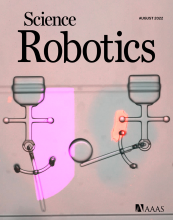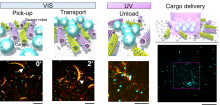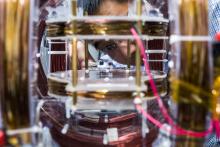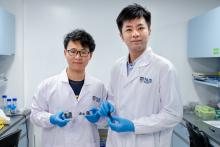Science Robotics
News
17 Nov 2022
Osaka University researchers simplified the process of producing soft microrobots powered by biomolecular motor muscles by 3D-printing the constituent modules, including actuators and grabbers, in situ. This work may lead to significant advances in scalable production and microsurgery.
20 Apr 2022
In a global first, scientists have demonstrated that molecular robots are able to accomplish cargo delivery by employing a strategy of swarming, achieving a transport efficiency five times greater than that of single robots.
13 May 2021
A spray-on magnetic coat turns any object into a robot controlled by a magnetic field. The biocompatible robots can walk, crawl and roll, and switch motions on demand.

01 Mar 2021
A joint research team co-led by City University of Hong Kong (CityU) has developed a new soft tactile sensor with skin-comparable characteristics. A robotic gripper with the sensor mounted at the fingertip could accomplish challenging tasks such as stably grasping fragile objects and threading a needle. Their research provided new insight into tactile sensor design and could contribute to various applications in the robotics field, such as smart prosthetics and human-robot interaction.

25 Nov 2020
An easy way to make millirobots by coating objects with a glue-like magnetic spray was developed in a joint research led by a scientist from City University of Hong Kong (CityU). Driven by the magnetic field, the coated objects can crawl, walk, or roll on different surfaces. As the magnetic coating is biocompatible and can be disintegrated into powders when needed, this technology demonstrates the potential for biomedical applications, including catheter navigation and drug delivery.
25 Nov 2019
A team from the National University of Singapore has created a material that is half as light as paper and highly flexible but also shows enhanced characteristics for electrical conductivity, heat generation, fire-resistance, strain-sensing and is inherently capable of wireless communications.
22 Aug 2019
Wearing a flower brooch that blooms before your eyes sounds like magic.
KAIST researchers have made it real with robotic muscles.

17 Jun 2019
Professor Hongsoo Choi’s team developed a microrobot that can precisely transplant stem cells in various in vivo and vitro environments. Expects to improve the efficiency of treating degenerative neural disorders such as Alzheimer by accurately and safely delivering to a desired location
Events
Sorry, no events coming up for this topic.
Researchers
Sorry, no researchers coming up for this topic.
Giants in history
Sorry, no researchers coming up for this topic.







